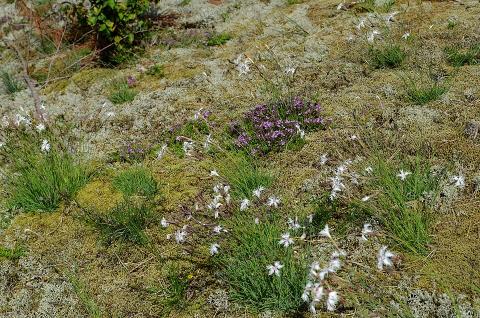
Timelines 10
Man and his Senses 10
Man and his Inventions 10
Geography 10
Fauna 10
Timelines 10
Man and his Senses 10
Man and his Inventions 10
Geography 10
Fauna 10

There is a useful contrast in scale and style between two conservation cultures. In the Czech Republic conservation often proceeds as a precise practice: small sites, slopes and single endemic plants are mapped, listed and protected by clearly defined action plans.
In India, by contrast, conservation is conducted across large biomes—Himalayan high lands, Western Ghats rainforests, the Indo-Burma corridor and Sundaland lowlands, which is integrated into development, livelihoods and large policy programs.
Both approaches matter; both are informed increasingly by the same modern tools. Take the Bohemian Sand Pink (Dianthus arenarius subsp. bohemicus), an example of Czech precision. This low, white-flowered perennial is a survivor from the Pleistocene confined to gravel-sand terraces near Roudnice nad Labem; its original habitat survives today in a small patch of sandy slopes at Kleneč, a site that has been protected since the 1930s and expanded in later decades.
The plant’s story is not rhetorical but administrative: it appears in a formal action plan and places the site within Natura 2000 and Important Plant Area frameworks. Such detailed work—mapping a single native site, quantifying its reserve area and tracking invasive species pressure—is the Czech way of tending a living archive.
The Czech action plan is a technical document as much as an appeal. It describes the species’ ecology (sand and gravel open grasslands, historical presence in dry pasture), notes the pressure of afforestation and invasive planting, and prescribes concrete measures: habitat management, monitoring, legal protection and local engagement. That procedural clarity is essential because the conservation unit is small and fragile; success is measured in hectares protected, recruitment of conservationists, and measures taken against encroachment. In short, Czech protection blends legal high level intervention with active, local stewardship.
India’s conservation task looks different on paper and in the field. As a megadiverse country it must steward not solitary endemics but entire biogeographical regions. The updated National Biodiversity Strategy and Action Plan (NBSAP), summarised for stakeholders, frames India’s response as a national mission that aligns biodiversity targets with development priorities and international commitments. The NBSAP provides the structure for reporting, agency roles and a set of national biodiversity targets that range from habitat restoration to community stewardship. This is an institutional framework built to manage complexity at continental scale.
This policy approach deliberately recognises hotspots and regionally distinct priorities. India’s ecological wealth—from alpine meadows to Western Ghats rainforests and the Indo-Burma corridor—demands differentiated responses: protected area expansion and connectivity in one place, community-led restoration in another, and species recovery programs where particular species face acute threat. The NBSAP’s structure thus tries to translate national ambition into regional, measurable action. It is conservation suited to variety and scale.
Technology is the connective tissue between these two national scripts. In the Czech case, the conservation record is built on formal reports and action plans that depend on reliable data: surveys, mapping and monitoring. The state’s environmental report collates trends, identifies pressures and helps prioritise resources—it is the instrument through which site-level action is justified and reviewed. Clear data, repeatedly gathered, is what lets a small plan for a sand pink be treated with the same seriousness as larger landscape programmes.

In India, AI and digital sensing are already becoming everyday conservation tools. Indian researchers and practitioners are deploying machine learning for tasks as varied as processing camera-trap footage, recognising bird calls from acoustic records, mapping species distributions from satellite imagery and detecting unusual patterns that suggest poaching or habitat degradation.
Case studies from Indian projects show how automated video and audio processing—powered by platforms and models trained on regional data—can dramatically reduce the labour of monitoring and increase the speed of detection. These tools are attractive because they scale: one well-trained model can sift thousands of hours of footage or acoustic recordings, turning noise into usable conservation intelligence.
This digital push is not an argument for simple optimism about technology. AI depends on good training data, careful curation and ethical governance. For eg false positives in camera traps waste scarce patrol time; biased datasets can overlook marginal species or habitats; and automated surveillance raises legitimate privacy and community rights concerns. Official summaries and stakeholder materials for the NBSAP make the same point: technology is a tool, but institutional design and local engagement decide whether it strengthens, or undermines, conservation outcomes.
Where the two national narratives meet is instructive. Czechia’s strength lies in very local, scientifically rigorous action plans that keep small endemics off the extinction list. India’s strength is institutional breadth: a national strategy that folds biodiversity objectives into development plans and that can steer AI and field methods into priority zones. Combine both approaches and you get a conservation model in which precise local interventions—the management of a Kleneč slope, for instance, sit inside a coordinated national system that can prioritise, fund and monitor interventions at scale.
There are practical commonalities to build on. Both countries require good baseline data, periodic monitoring and clear legal frameworks; both gain when policy and science talk to one another; and both benefit when communities are enlisted as custodians rather than passive recipients. In the Czech context this means landowners and local managers implementing prescribed mowing, removal of invasive trees and careful visitor management. In India it translates to community-based monitoring, species recovery projects and the use of AI-assisted tools by forest departments and citizen scientists alike.
Finally, there is symbolism to conservation : The Bohemian Sand Pink is not merely a botanical footnote; it is a piece of geological and cultural memory pinned to a landscape. Likewise, India’s hotspots are repositories of evolutionary history and human culture, their loss a blow to both biodiversity and livelihood.
Technology and policy can be practical instruments—maps, models, action plans—but the deeper task is one the Czech action plans and India’s NBSAP both acknowledge: to maintain a living relationship between people and place so that species and the stories they carry endure.
If conservation has a style guide it would read like this: gather precise data, write explicit action, enlist local knowledge, and use modern tools where they help. The Czech Republic shows how smallness need not be small-minded—a single endemic species can shape whole programmes of protection. India shows how scale can be structured so that national commitments become local practice.
Both lessons are urgent. In an age of rapid environmental change, the care of a sand pink and the mapping of a mountain forest are chapters of the same story.
Sources:
https://tinyurl.com/ya8zqdr9
https://tinyurl.com/24f2qfpx
https://tinyurl.com/2837gdbt
https://tinyurl.com/2cwq4pwk
https://tinyurl.com/2yn8dfz9
https://tinyurl.com/2c887j5s
https://tinyurl.com/22hqbkte